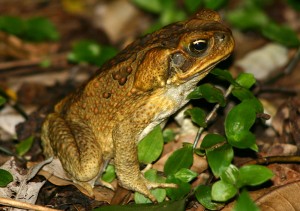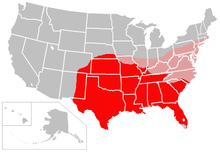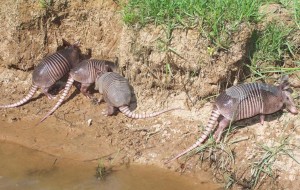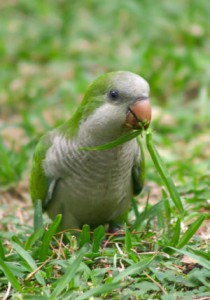So for the most part, anyone familiar with the Museum knows that we concentrate mainly on native species in our animal collection. There are of course a few exceptions. The Lemurs would normally hail from Madagascar, the education Bearded Dragons would be from Australia (and I myself am originally from New York City). But all in all, our “wild species” (sorry, Lightning-you don’t count!) are from somewhere in good old NC. But here’s the interesting part… our state species list doesn’t always stay the same. And it’s not just our state – lots of states have what are called “introduced” or “invasive” species. When I was living in Florida, the whole place was full of them. Florida is a sub-tropical state and very conducive to many species living there. They are having huge problems with things like marine toads, certain tropical fish that have inundated the waterways and even some species of parrots live free and wild in the sunshine state. And those are just the tip of the iceberg. North Carolina has a much harsher winter climate than Florida, so our increasing species list is not quite as extensive, but we do have our fair share of newcomers.


One animal that is becoming increasingly abundant in the southern part of the state and whose range has been steadily spreading for years now is one you’ll never mistake for anything else… The Armadillo! The Nine Banded Armadillo (Dasypus novemcinctus) to be exact.

Once common to the very southern states like Texas, Oklahoma, Arkansas, and Florida these little tanks have been constantly moving their range further north and east. They have been sighted in our state most usually on the southernmost stretch between Wilmington and Charlotte. If their trend continues, they will have spread across the majority of the state in the next two to three years. That’s all is took them to occupy almost all of South Carolina from their appearance in 1995.

The ability of the armadillo to spread so successfully is due mainly to it’s high reproductive rate, lack of natural predators, and little desire of the American people to hunt and eat them. They probably won’t get much farther than Ohio, New Jersey and Pennsylvania due to their inability to handle the harsh winter climates. They are mainly insectivorous and can be fairly destructive to areas in their search to dig up delicious crawly treats. They also dwell in burrows that they dig and which do a great service to other species because when they vacate their burrows, these are quickly utilized by skunks, rattlesnakes, burrowing owls and numerous other species.
Contrary to popular belief, the Nine-Banded Armadillo cannot roll itself into a ball to protect itself. It can run away quickly when startled, jump a few feet into the air and, if all else fails-will quickly dig a shallow trench to wedge itself in. Their armor does provide a great amount of protection, as most predators cannot get through the shell and quickly grow discouraged and give up.

And what else is very interesting about the armadillo is their reproductive strategy. The female will give birth to 4 young at a time and they are all identical to each other. The quadruplets come from one fertilized egg which splits into 4 separate embryos which then develop alongside each other and result in a litter of 4 which will nurse from their mother for approximately 3 months and stay with her for between 6 months to a year. They can breed at one year old, and every year thereafter for the rest of their 12-15 year lifespan. One female can give birth to over 50 young, which is why their population is growing so quickly.
We have some time before they are permanently visiting us in the Durham area, but as of now keep an eye out if you’re driving along the southern part of the state. They like to frequent the sides of the roadways and don’t have the best eyesight, so wave and smile as you swerve around them on the highway. And enjoy our very newest and truly unique new state resident.


Time to introduce armadillo chili to NC State tailgate parties. Having sampled both Eastern and Lexington barbecue here (I’m from Texas, myself), I know North Carolinians are up to the challenge of armadillo meat. Great article, Mikey.
Texas speed bumps, in NC??!!
Kidding aside, someone once told me that they (Armadillos) sometimes jump straight up into the air when startled, as you’ve suggested. Years ago, while photographing some sort of wildlife along a roadside canal in Florida, I looked over my shoulder at an approaching vehicle. Just as I did, an armadillo leaped (leapt?) straight up from the road, but unfortunately not high enough. It was only a glancing blow, though, and the thick-skinned little critter rolled off to the side of the road for several yards, got up, and high-tailed it for cover.
My-my, armadillos in NC. I can’t wait!
Yay, Armadillos! They are so cute.
Thanks for the great comments everybody! I’m so excited to see them here too! (Wendy, we can’t eat them until they get fully established!) 🙂
And Greg, not only can they jump, but they are super fast when they want to be! Trust me, I know…
Now we just have to get one at the museum… Mwah ha ha! 🙂
Very cute story!!! Love it 🙂